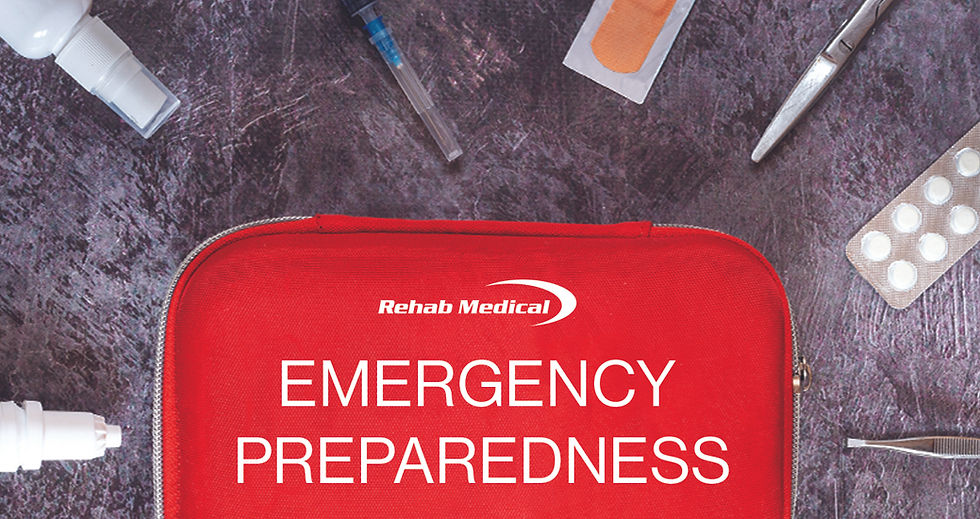A Safety Guide for House Fire Preparedness
- Rehab Medical

- Dec 19, 2023
- 3 min read

In the case of emergencies, preparedness becomes our greatest ally for facing unique challenges such as a house fire. Unlike public spaces, homes lack marked fire exits, emphasizing the importance of a personalized plan for individuals with mobility challenges. This guide delves into the focal points of preparing for a house fire for wheelchair users and their caregivers, offering key insights into recommendations from trusted sources.
For caregivers, the responsibility extends beyond assisting with basic care assistance. If you're a caregiver, you're the unsung hero, and your role goes beyond just being present—it's about leading, planning, and executing in a storm. Consider creating a comprehensive emergency plan together. Ensure everyone is on the same page, creating a script for a well-coordinated response. Remember, being a caregiver is an influential role, and your preparedness is a beacon of strength for your loved one. Keep being the hero you are in the lives of others!
Key Considerations
Your home can quickly transform into danger in the event of a fire. Wheelchair users and caregivers should intimately know the layout of the living space. Identify not just one but multiple exit paths, considering alternative routes in case of blockage. Regularly practicing these exits is crucial—it could make all the difference in a critical moment.
Every second counts. As a wheelchair user, having an emergency kit ready becomes a game-changer. Pack it with necessary medication, medical records, identification, and crucial contacts. Keep this kit within arm's reach for swift access in the event of a fire.
Keep communication lines open with local fire departments. Understand their recommendations for assisting wheelchair users during a fire and incorporate them into your emergency plan. Familiarize yourself with community resources and support networks that can help during and after emergencies. Consider obtaining a medical alert system for quick connection with crisis emergency services.
Emergency Planning
Sit down with your loved one to create a comprehensive emergency plan, defining roles and responsibilities to ensure everyone is on the same page. Identify a designated meeting point outside the home and practice the evacuation plan regularly. Regular reviews and updates adapt the plan to changing needs and circumstances.
Understanding how to assist a wheelchair user in emergencies is crucial for caregivers. Enroll in training programs covering safe transfer techniques, equipping you with valuable skills to navigate challenging situations. Regular training enhances confidence and preparedness. Consider involving other family members or neighbors in training sessions to broaden the support network.
Emergency Kit Enhancements
Tailor your emergency kit to your specific needs. Include a list of medications, dosage instructions, and relevant medical history. Consider adding non-perishable snacks, a spare charger for your communication device, and personal hygiene items. Keep the kit in a designated, easily accessible spot, periodically checking and updating its contents.
Your wheelchair, your trusted companion, deserves a safety check. Look closely for potentially flammable materials or components. Regularly inspect the wiring, ensuring no exposed or damaged parts. Consider the associated risks, such as battery issues, and follow regular maintenance and manufacturer guidelines to prevent potential fire hazards.
Fire Department Assistance
Take the extra step of informing local fire departments about mobility challenges. Provide detailed information about the home's layout, exit strategies, and any specific needs. This proactive approach empowers emergency responders to tailor their responses quickly and effectively. In addition, participation in community outreach programs conducted by fire departments further enhances overall awareness and preparedness.
Red Cross emphasizes the importance of creating a home fire escape plan and regularly practicing with all household members. Ensure everyone knows two ways to escape from every room and designate a meeting place outside. QuakeKare suggests keeping a flashlight in your emergency kit and checking its batteries regularly, which is particularly useful for wheelchair users navigating low-light conditions.
Remember, preparedness is your superpower. Preparing for a house fire is a personal journey, especially for wheelchair users navigating potential obstacles with effectiveness. By weaving personalized strategies into your emergency plan, you enhance your safety and contribute to your community's strength.
Resources - https://judy.co/blogs/content/wildfire-prep-101-what-to-do-before-during-and-after-a-fire - https://www.redcross.org/get-help/how-to-prepare-for-emergencies/types-of-emergencies/fire/home-fire-preparedness.html - https://unitedspinal.org/9-wildfire-preparedness-resources-for-people-with-disabilities/



Comments